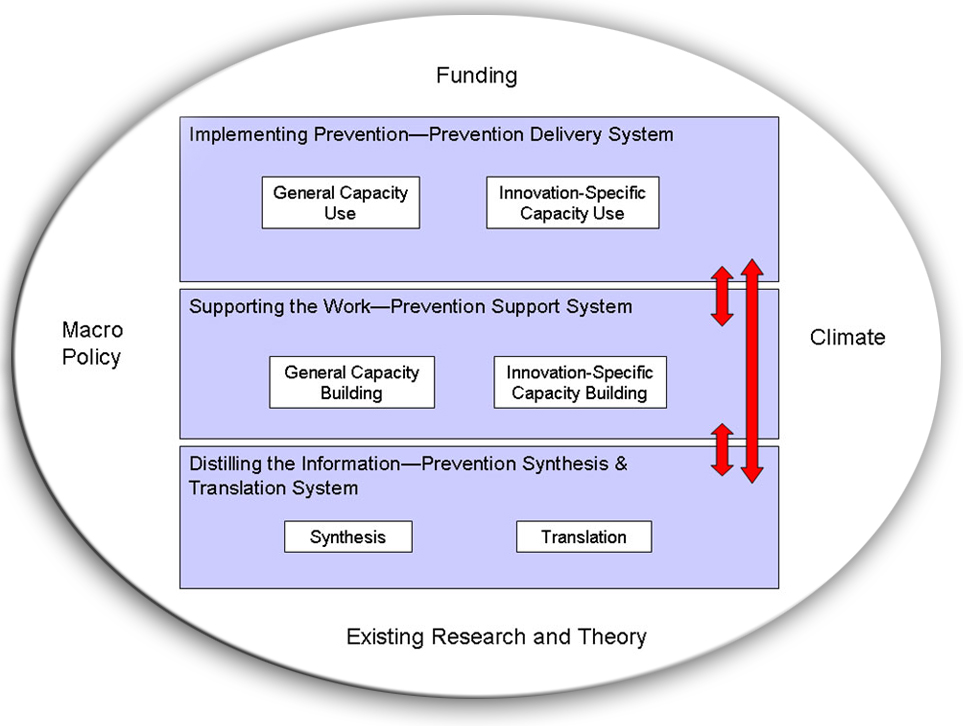
Youth Violence Navigation
- Home
- Definitions
- Data Sources
- Risk and Protective Factors
- Consequences
- Prevention Strategies
- Translation
- Additional Resources
Youth Violence Prevention
Scientific Information: Translation
Translation characterizes the sequence of events from discovery of new knowledge (i.e., an innovation) to its adoption and use in practice settings. It does not encompass pure foundational or formative basic "discoveries" (e.g., discovery of risk and protective factors, causal pathways, or etiology research). Translation is comprised of many complex activities of which the specifics elements are defined below.1
-
Dissemination: The intentional targeted spreading of information or technology about an innovation - product, practice, program, policy, idea, research findings, or results - from the originators to the intended users (specific public health audiences and other key stakeholders receptive to them). The result is a targeted and facilitated process of distributing information and materials to organizations and individuals who want and can use them to improve health.1
-
Implementation: A purposeful set of specific activities designed to put an innovation - idea, product, policy, program or practice – to use, including the decision to use an innovation, commitment of needed resources, and actual use. The result is individual or organizational adoption of an innovation - product, practice, program, policy, idea, research findings, or results.1
-
Diffusion: Processes whereby an innovation -- product, practice, program, policy, idea, research findings or results – moves into widespread use or common understanding. The result is the uptake of new practices, the penetration of broad scale recommendations, or more evidence-based health decision-making in both the public and the private sectors. Strategies to influence diffusion may include dissemination and implementation initiatives, marketing, laws and regulations, systems research, and policies.1
Note: These are working definitions developed by CDC's Knowledge to Action workgroup. If you would like more information on these definitions, please contact k2a@cdc.gov.
Overview of the Interactive Systems Framework for Dissemination and Implementation
The Interactive Systems Framework for Dissemination and Implementation shows key elements and relationships involved in the movement of knowledge of research into practice. While it is primarily descriptive, it also has implications for how the dissemination and implementation process might be improved. The Framework consists of three systems: the Prevention Synthesis and Translation System, the Prevention Support System, and the Prevention Delivery System. The term system is used broadly here to describe a set of activities that may vary in the degree to which they are systematic or coherently organized.
The function of the Prevention Synthesis and Translation System is conceptualized as distilling information about scientific innovations and preparing them for implementation by end users (e.g., practitioners). The function of the Prevention Support System is conceptualized as supporting the work of those who will put the innovations into practice. The primary function of the Prevention Delivery System is the implementation of innovations (e.g., delivery of programs) in the field.2
The Interactive Systems Framework for Dissemination and Implementation

Translational Research
Research is continuing to identify programs and strategies that reduce or ultimately prevent various types of violence. For these programs or strategies to reach the broadest audience possible, applied translational research about their dissemination, implementation, and diffusion is necessary. For example, a program's effectiveness may vary depending on the setting in which it is delivered. Translational research may examine the effect of a program in different settings including the workplace, schools, churches, and community centers. CDC's research on translation helps guide the adaptation of programs and strategies to specific communities, subcultures, and populations with the goal of enhancing their effectiveness.
Resources
National
Implementation Research Network
The National Implementation Research Network seeks to close the gap between science and service by improving the science and practice of implementation in relation to evidence-based programs and practices.
National Youth Violence Prevention Resource Center*
Developed by CDC in partnership with 10 other federal partners, the Resource Center provides current information pertaining to youth violence that has been developed by federal agencies and the private sector.
The NYVPRC is a gateway for professionals, parents, teens, and other
interested individuals to obtain comprehensive information about youth
violence—including suicide prevention and intervention.
Reference
Wandersman, A., Duffy, J., Flaspohler, P., Noonan, R., Lubell, K., Stillman, L., Blachman, M., Dunville, R., & Saul, J. (2008). Bridging the gap between prevention research and practice: The Interactive Systems Framework for Dissemination and Implementation. American Journal of Community Psychology, 41, 171-181.
Page last modified: July 16, 2008
